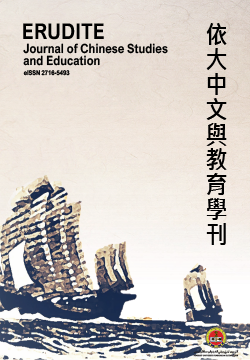二十世纪马来亚甲骨文书法实践初探 ——以南来书家为中心
An Exploration of 20th Century Malaya Oracle Bone Script Calligraphy Focusing on Calligraphers Coming to the South
DOI:
https://doi.org/10.37134/erudite.vol2.1.5.2021Keywords:
南来书家, 甲骨文书法, 马来亚, 二十世纪甲骨文书法, 文字画Abstract
二十世纪上半叶,中国掀起了一股文人移居马来亚的浪潮,这批文人中包含了不少优秀的书家——“南来书家”,他们成为马来亚书法的奠基与开拓者,甲骨文书法也伴随南来书家的到来而开启了新一支中国地区以外的实践场域。时光飞逝,新马分家至今,南来书家甲骨文书法实践逐渐地埋没于时光长河,至今仍未得到整理与分析。基于此,笔者尝试对南来书家甲骨文书法实践进行梳理,通过收集、分析散落四处的甲骨文作品及言论,试图窥看当时甲骨文书法的实践情况。
通过分析,可发现南来书家普遍都通过集甲骨文工具书进行创作,在创作方向上,诸多书家延续了传统书法的审美与技法来实践甲骨文书法,多是继承并延续中国甲骨文书法的成果,因对甲骨文认知的深浅有别,造成了书家之间水平存在明显地差距。另一方面,也有书家于马来亚受到东西文化冲击进而思考中国书法的艺术发展空间,并使用甲骨文文字为创作素材进行了一系列探索创作,为甲骨文书法实践领域留下了宝贵的历史图像。
In the first half of the twentieth century, China set off a wave of literati emigrating to Malaya. This group of literati included many outstanding calligraphers who have known as “calligraphers coming to the south”. They were the founder and pioneer of Malayan calligraphy. Oracle bone inscription calligraphy also opened up a new field of practice outside of China with the arrival of calligraphers coming to the south. Time flies, and since the division of Singapore and Malaysia, the practice of the oracle bone inscription calligraphy of the calligraphers coming to the south has gradually been buried in the long river of time, and has not yet been sorted and analyzed. Based on this, I tried to sort out the practice of oracle bone inscription calligraphy by the calligraphers coming to the south, and tried to get a glimpse of the practice of oracle bone calligraphy at that time by collecting and analyzing the oracle bone inscription calligraphy and comments scattered around.
Through analysis, it can be found that the calligraphers coming to the south generally used the oracle bone inscription to create their artwork. In the direction of creation, many calligraphers continued the aesthetics and techniques of traditional calligraphy to practice the oracle bone inscription calligraphy, and most of them inherited and continued the achievements of the China oracle bone calligraphy. Due to differences in the depth of knowledge of oracle bone inscription, there was a clear gap between the level of calligraphers. On the other hand, some calligraphers in Malaya were impacted by Eastern and Western cultures to think about the artistic development space of Chinese calligraphy, and used oracle bone inscriptions as creative materials to carry out a series of exploration and creation, leaving a valuable historical for the practice of oracle bone inscription calligraphy.
Keywords: calligraphers coming to the south, oracle bone inscription calligraphy, Malaya, 20th century oracle bone inscription calligraphy, word painting
Downloads
References
【征引文献】
一、作品集、图录
丁 仁,《商卜文字集联(附诗)》,石印本,1928。
___,《观水游山集(集商卜文)》,墨缘堂石印,1937。
王原人,《崔大地书法》,新加坡:崔大地书法筹备委员会,2019。
叶正渤,《叶玉森甲骨学论著整理与研究》,北京:线装书局,2008。
叶昆灿、廖宝强、谢清水、曾渊澄、杜珠成,《松年法师书法艺展特刊》,新加坡:华文中学教师,1977。
吕佛庭,《万物静观.艺进于道:吕佛庭书画展及其传承》,台北:中华文化总会,2016。
许云樵编,《瘦石遗墨附论书》,新加坡:胡云华,1979。
松年,《墨痕心影》,新加坡:首都印务私人有限公司,1986。
罗振玉,《集殷墟文字楹帖》,贻安堂影印,1921。
罗振玉、章玉、高德馨、王季烈,《集殷墟文字楹帖汇编》,东方学会石印,1927。
杨金荣,《第五届(2011)马来西亚全国书法大展专集》,吉隆坡:马来西亚书艺协会,2011。
施香沱,《施香沱书法》,新加坡:啸涛篆刻书画会,1980。
黄岩博物馆编,《管震民书画集》,杭州:西泠印社出版社,2018。
简经纶,《甲骨集古诗联(上编)》,上海:商务印书馆,1937。
二、专著
刘宗超,《中国书法现代史》,杭州:中国美术学院出版社,2001。
黄尧,《墨缘随笔》,吉隆坡:雪兰莪中华大会堂文教委员会,2000。
管震民先生七秩荣纪念寿管委员会编,《绿天庐吟草》,槟城:星槟日报,1949。
廖文辉,《马来西亚》,台北:联经出版社,2019。
三、学位与期刊论文
陈爱民,〈二十世纪甲骨文书法研究〉,南京:南京艺术学院美术学博士论文,2011。
___,〈甲骨的终结与甲骨文书法的艺术转换——论罗振玉《集殷虚文字楹帖》的书学意义和价值〉,《艺术百家》第5期,2006,页183-185。
___,〈甲骨遗风,红茶墨韵——谈沈红茶山水甲骨文字画的历史渊源与艺术特色〉,《文化月刊》第12期,2018,页162-163。
陈玉佩,《近百年来华文书法在马来西亚的传播与发展》,广州:暨南大学文艺学硕士论文,2005。
___,〈崔大地的书法艺术和贡献〉,《中华人文碑林兰亭奖》,2017。
姜栋,《20世纪大陆地区甲骨文书法实践状况研究》,北京:首都师范大学美术学硕士论文,2006。
容庚,〈甲骨文字之发现及其考释〉,《国学季刊》第4期,1924。
黄惇,〈当代中国书坛格局的形成与由来——20世纪末的思考〉,《中国书画》第5期,2006,页152-153。
四、报章
〈访书法家崔大地〉,《星洲日报》第14版,1965年11月11日。
〈南大中国书画研究会日昨请陈景昭讲述中国书法〉,《南洋商报》第21版(新加坡新闻),1970年11月1日。
Violet Oon,“The Beauty of Calligraphy” ,New Nation, 3 February 1973, p.11。
五、网络资料
王南溟,〈从对“图画文字”到“文字画”的实践〉,“黄尧HuangYao”,网址http://www.huangyao.org/795.html,2001年发表,检索日期:2020年9月15日。
“黄尧HuangYao”,网址http://www.huangyao.org/795.html,2001年发表,检索日期:2020年9月15日。





